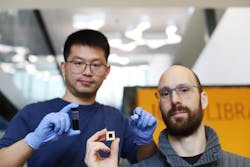A fundamental roadblock currently exists in turning shortwave infrared (SWIR)-sensitive quantum dots into a key enabling technology for mass-market applications, because they often contain heavy metals like lead, cadmium, or mercury—which are subject to the Restriction of Hazardous Substances (RoHS) regulation, a European Union directive that restricts the use of these toxic materials within consumer electronic applications.
Original equipment manufacturers (OEMs) operating within the consumer electronics space requested quantum dot technology that eliminates these toxic elements, so a team of researchers led by Gerasimos Konstantatos, a professor of functional optoelectronic nanomaterials at The Institute of Photonic Sciences (ICFO), set out to create nontoxic quantum dots (see Fig. 1) that can function at room temperature (see video).
“It’s important to realize the use of lead, cadmium, or mercury within an academic setting—where nearly all prior work on quantum dots in the infrared is based on such elements—can actually be a major roadblock to the adoption of the technology by the electronics industry,” says Konstantatos. “We should focus on exploring and developing nontoxic alternatives, because at the end of the day we’d like to see the lab-based technologies we’re developing have an impact on the market and society.”
Research serendipity
The team was working on a project to develop nontoxic solar cells based on silver bismuth sulfide (AgBiS2) nanocrystals, in an attempt to reduce the bandgap of this material to capture more solar light, when it led to an intriguing and serendipitous discovery.
Their method synthesizes size-tunable phosphine-free silver telluride quantum dots while preserving the advantageous properties of their heavy-metal counterparts—and paves the way to bringing SWIR colloidal quantum dot technology to high-volume markets.
While exploring how to synthesize silver bismuth telluride (AgBiTe2) nanocrystals to extend their spectral coverage to enhance the performance of photovoltaic devices, the researchers ended up with a silver telluride (Ag2Te) byproduct.
“We’d explored the possibility of making AgBiTe2, but then we got a solution that showed a nice exciton peak-like absorption spectra that changes with the size of the nanocrystals—and it pointed toward the formation of quantum dots,” explains Konstantatos. “We then analyzed these quantum dots and discovered they were Ag2Te quantum dots, which we immediately realized could be a promising candidate for lead-free optoelectronics—photodetectors, in particular.”
They recognized its potential for SWIR photodetectors (see Fig. 2) and image sensors and pivoted their efforts to achieve and control a new process to synthesize phosphine-free versions of silver telluride quantum dots, because phosphine may have a detrimental impact on the optoelectronic properties of the quantum dots relevant to photodetection.
The team’s new synthetic method relies on different phosphine-free complexes, such as tellurium and silver precursors, which led them to quantum dots with a well-controlled size distribution and excitonic peaks over a broad range of the spectrum. After fabricating and characterizing them, their synthesized quantum dots showed remarkable optical properties—distinct excitation peaks over 1500 nm.
So, they used their phosphine-free quantum dots to fabricate a simple lab-scale photodetector on an indium-tin-oxide-coated glass substrate to characterize the devices and measure its properties.
Initially, their photodiode showed a low performance sensing SWIR light, which prompted a redesign that involved adding a buffer layer. The adjustment enhanced the photodetector’s performance—resulting in a SWIR photodiode with a spectral range from 350 nm to 1600 nm, a linear dynamic range exceeding 118 dB, a -3 dB bandwidth surpassing 110 kHz, and a room temperature detectivity on the order of 1012 Jones.
Their biggest challenge along the way was figuring out how to layer the quantum dot stack to form a properly functioning diode. Integration of the stack from a lab-based glass substrate onto a complementary metal-oxide semiconductor (CMOS) focal-plane array also took some time to develop and optimize.
Collaboration with Qurv
After the successful development of their heavy-metal-free quantum dot-based photodetector, the researchers went a step further and teamed up with Qurv, an ICFO spinoff, to demonstrate its potential by building a SWIR image sensor as a proof of concept.
The team integrated the new photodiode with a CMOS-based read-out integrated circuit (ROIC) focal-plane array and demonstrated for the first time a proof-of-concept, nontoxic, room temperature-operating SWIR quantum dot-based image sensor. They put its operation within the SWIR to the test by taking several pictures of a target object, and managed to image the transmission of silicon wafers under SWIR light and see the content of plastic bottles that were opaque within the visible light range.
“Accessing the SWIR with a low-cost technology for consumer electronics will unleash the potential of this spectral range with a huge range of applications, including improved vision systems for the automotive industry to improve visibility and driving during adverse weather conditions,” says Gerasimos Konstantatos. “The SWIR band around 1.35 to 1.40 microns, can provide an eye-safe window, free of background light under day/night conditions, and further enable long-range light detection and ranging (LiDAR), as well as three-dimensional imaging for automotive, augmented reality, and virtual reality applications.”
To the best of the team’s knowledge, they’re the first to achieve solution-processed nontoxic SWIR photodiodes with a compelling performance and integrate them onto a CMOS ROIC. “Our results further support the fact that Ag2Te quantum dots are a promising RoHS-compliant material for low-cost, high-performance SWIR photodetector applications,” says Konstantatos.
The team is now focusing on “increasing the performance by increasing the quantum efficiency of the detectors and will further assess and improve their environmental and temperature resilience,” Konstantatos adds.
FURTHER READING
Y. Wang et al., Nat. Photon. (2024); https://doi.org/10.1038/s41566-023-01345-3.


